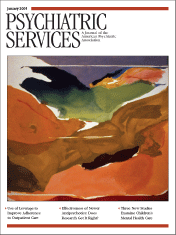Use of Leverage to Improve Adherence to Psychiatric Treatment in the Community
Abstract
OBJECTIVES: A variety of tools are being used as leverage to improve adherence to psychiatric treatment in the community. This study is the first to obtain data on the frequency with which these tools are used in the public mental health system. Patients' lifetime experience of four specific forms of leverage—money (representative payee or money handler), housing, criminal justice, and outpatient commitment—was assessed. Logistic regression was used to examine associations between clinical and demographic characteristics and receipt of different types of leverage. METHODS: Ninety-minute interviews were conducted with approximately 200 adult outpatients at each of five sites in five states in different regions of the United States. RESULTS: The percentage of patients who experienced at least one form of leverage varied from 44 to 59 percent across sites. A fairly consistent picture emerged in which leverage was used significantly more frequently for younger patients and those with more severe, disabling, and longer lasting psychopathology; a pattern of multiple hospital readmissions; and intensive outpatient service use. Use of money as leverage ranged from 7 to 19 percent of patients; outpatient commitment, 12 to 20 percent; criminal sanction, 15 to 30 percent; and housing, 23 to 40 percent. CONCLUSIONS: Debates on current policy emphasize only one form of leverage, outpatient commitment, which is much too narrow a focus. Attempts to leverage treatment adherence are ubiquitous in serving traditional public-sector patients. Research on the outcomes associated with the use of leverage is critical to understanding the effectiveness of the psychiatric treatment system.



